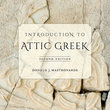 Accentuation Tutorial
Accentuation Tutorial

|
TOPICS Accent and Accent-Marking in Ancient Greek The Last 3 Syllables and the Accents Enclitics Persistent Accentuation |
The effect of an enclitic on the preceding word can generally be understood by reference to the requirements of contonation and mora. The preceding word retains its usual accent and contonation, and in some situations a second accent and contonation is added because the word unit (consisting of main or head word and the following enclitic) has too many morae after the original contonation. The rules for treatment of word units containing enclitics may be expressed under three headings. (a) A word accented on U keeps its acute or circumflex. The acute is not changed to a grave, because the acute is not on the final syllable of the word unit. In the case of a circumflex on U, the rule of one mora after the contonation appears to be violated: possibly the written accent system here fails to reflect the actual pronunciation and is simply conventional. (In the following examples, the word unit of head word plus enclitic is in brown and the contonation is underlined.) καλός τε καὶ ἀγαθός – “noble and good”; acute on U unchanged σοφαί τινες – “some wise women”; acute on U unchanged γυναικῶν τινων – “of certain women”; circumflex on U unchanged (mora rule violated) |
||||